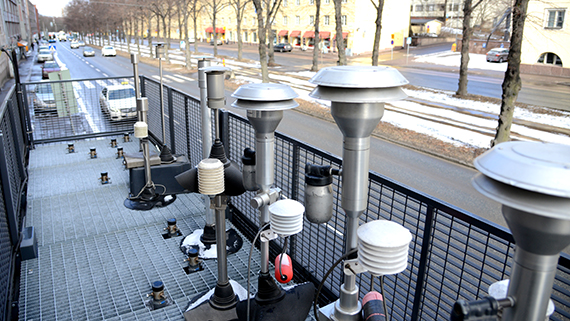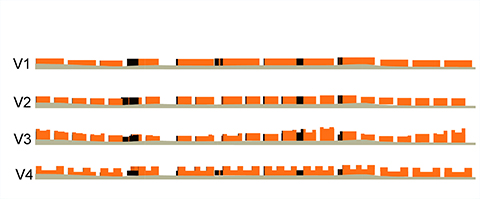Air quality in city streets and boulevards affected by surrounding buildings

The new Helsinki City master plan includes areas of new city development where the aim is to change the existing access routes inside the Ring Road I into urban boulevards lined with residential and commercial buildings. According to the study conducted by the Finnish Meteorological Institute and the University of Helsinki, the structure of the blocks surrounding the boulevard streets has a significant impact on the air quality in the streets. The study compared four different types of blocks and one of the solutions proved to be clearly better than the others in this respect.


Block models studied V1 - V4. In the top picture the colour indicates the height of the buildings and the ground. The darkest shade of green represents the maximum height. The picture below shows the cross sections of the block models. The study showed that block model V3 was best for ventilation and reducing air pollution.
"The best solution in terms of air quality are blocks of different heights, which contribute to the transfer of air pollution from the street level. In this solution, the short façades of the blocks face the boulevard and the height of the blocks varies gradually from one block to the other in the direction of the street," says Finnish Meteorological Institute researcher Antti Hellsten. More efficient ventilation reduces concentrations of harmful pollutants to which people are exposed at street level. According to the modelling this sort of construction method allows the air to flow providing good ventilation.
Supercomputers make exceptionally detailed dispersion modelling possible
Such detailed air pollution dispersion modelling in an urban environment has not been carried out anywhere else in the world. The area of study was focussed on four theoretical urban boulevard plans drawn up for the Hämeenlinnanväylä area. The simulations were made at the Finnish Meteorological Institute on a Cray XC30 supercomputer running four hundred computing processes in parallel. In the study the air flow and its entrained air pollutant concentrations were modelled using a large-eddy simulation model. The study took into account not only the buildings but also the air braking effect of trees in the street and the surroundings, as well as the effect of the weather on the ventilation.
The work was done in collaboration with the University of Helsinki's Research Division of Atmospheric Sciences, as well as the Helsinki Region Environmental Services Authority (HSY). The study was commissioned by the Helsinki City Planning Department. The study used methods developed for the Academy of Finland funded CityClim research project, as well as other methods.
More information:
Senior Research Scientist Antti Hellsten, Tel. +358 50 409 0477, antti.hellsten@fmi.fi
Researcher Mona Kurppa, Tel. +358 400 991 944, mona.kurppa@helsinki.fi
Researcher Mikko Auvinen, Tel. + 358 29 415 0714, mikko.auvinen@helsinki.fi
Link to the final project report: http://www.hel.fi/hel2/ksv/julkaisut/yos
Link to an animation describing the wind field: https://youtu.be/hTi2HPikJvk
Link to an animation showing the migration of pollutant concentrations close to the street level: https://youtu.be/6HTeWcBy1Fw
